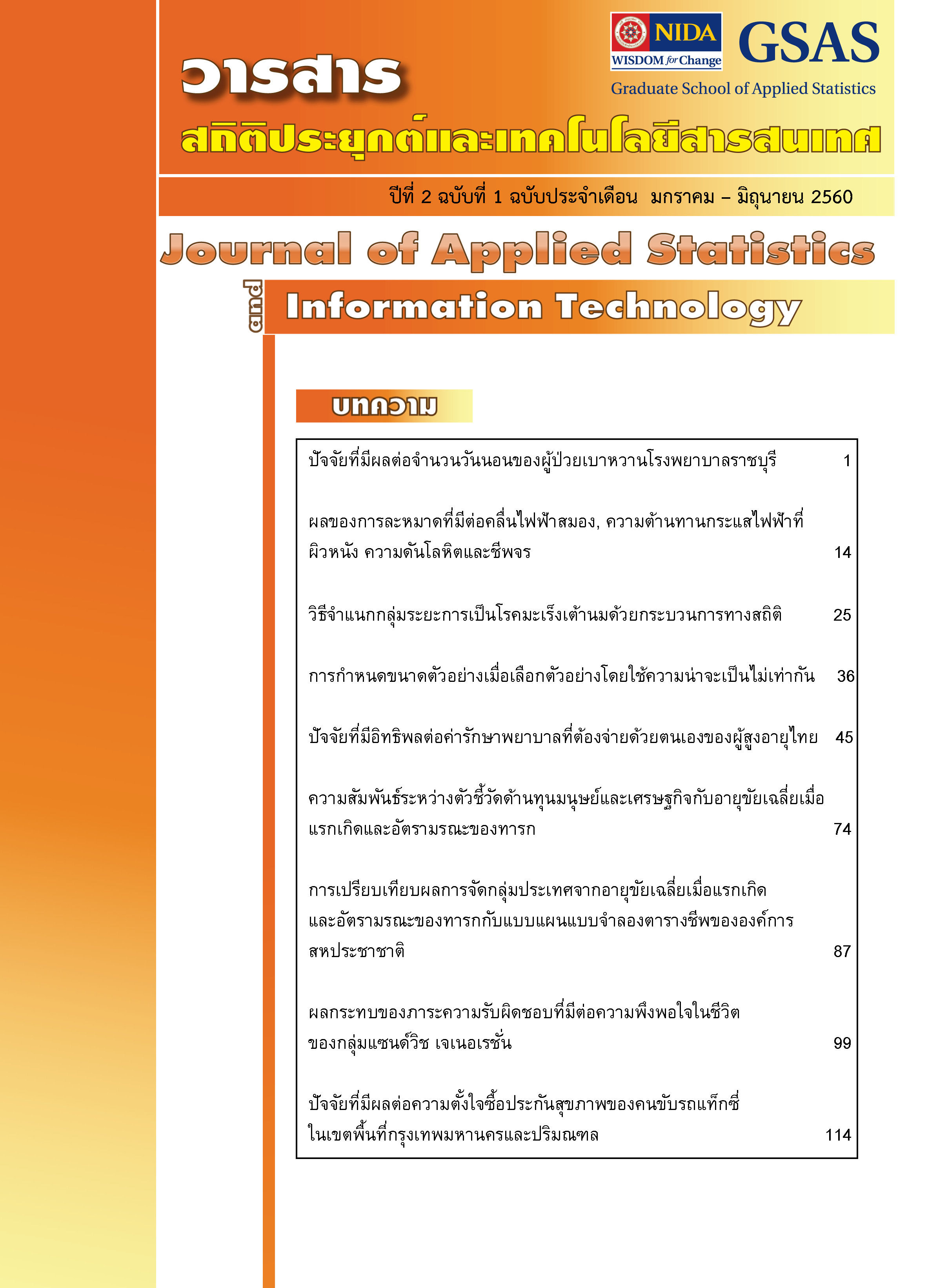CLASSIFICATION GROUPS FOR THE STAGE OF BREAST CANCER WITH STATISTICS METHOD
Keywords:
Breast cancer, Ordinal Logistic Regression Model, Discriminant Analysis Model, Wald statistic, Wilks' LambdaAbstract
This research is prediction of a model of possibility for detection of non- breast cancer and breast cancer and stages of breast cancers. Assessment of characteristics of abnormal growth of breast cancer cells such as Clump Thickness (X1), Uniformity of Cell Size (X2), Uniformity of Cell Shape (X3), Marginal Adhesion (X4), Single Epithelial Cell Size (X5), Bare Nuclei (X6), Bland Chromatin (X7), Normal Nucleoli (X8), and Mitoses (X9) are independent variable. The dependent variable is the probability that the patient is detected at any stage of breast cancer or non-breast cancer based on the tumor cells with abnormal growth of breast cancer by using Ordinal Logistic Regression Model and Discriminant Analysis Model. In conclusions Ordinal Logistic Regression Model can use few variables in prediction of stages of breast cancer and Ordinal Logistic Regression Model has 55.50% classification higher than Discriminant Analysis Model has 54.10% classification. Ordinal Logistic Regression Model showed classification accuracy as following: non-breast cancer 73.60%, breast cancer stage 1- 4 as 5%, 43.6%, 61.4% and 76.4% respectively. Nine predicted variables were used in Discriminant Analysis Model and classification accuracy was recorded as non-breast cancer 56%, breast cancer stage 1- 4 as 49.1%, 35.6%, 72.6% and 60% respectively.
References
สถาบันมะเร็งแห่งชาติ (2550). แนวทางการตรวจวินิจฉัยและรักษาโรคมะเร็งเต้านม.พิมพ์ครั้งที่ 1 พ.ศ. 2550. กรุงเทพฯ :
กรมการแพทย์ กระทรวงสาธารณสุข (2546). การประเมินเทคโนโลยีการตรวจวินิจฉัยมะเร็งเต้านมในระยะเริ่มแรกที่เหมาะสมสำหรับประเทศไทย: ตุลาคม 2546. หน้า28-30.
ชุดฐานข้อมูลจาก Wisconsin Breast Cancer Database (WBCD). http://www.archive.ics.uci.edu/ml/dataset.html.
วีรานันท์ พงศาภักดี (2541). การวิเคราะห์ข้อมูลเชิงกลุ่ม : ทฤษฎีและการประยุกต์ (GLIM และ SPSS/FW). พิมพ์ครั้งที่ 2. นครปฐม: ภาควิชาคณิตศาสตร์ คณะวิทยาศาสตร์ มหาวิทยาลัยศิลปากร วิทยาเขตพระราชวังสนามจันทร์, 2541.
กัลยา วานิชย์บัญชา. (2551) การวิเคราะห์ข้อมูลหลายตัวแปร. พิมพ์ครั้งที่ 3. กรุงเทพมหานคร: โรงพิมพ์แห่งจุฬาลงกรณ์มหาวิทยาลัย.
กัลยา วานิชย์บัญชา. (2551) การวิเคราะห์สถิติขั้นสูงด้วย SPSS for Windows. พิมพ์ครั้งที่ 6. กรุงเทพมหานคร: โรงพิมพ์แห่งจุฬาลงกรณ์มหาวิทยาลัย.
ศิริชัย กาญจนวาสี (2550) . การวิเคราะห์พหุระดับ (Multi-Level Analysis) . พิมพ์ครั้งที่ 4. กรุงเทพมหานคร:โรงพิมพ์แห่งจุฬาลงกรณ์มหาวิทยาลัย
Agresti, A., (2002). Categorical Data Analysis. 2nd rev-ed., New York: John Wiley & Sons,2002.
Lachin JM. (2000). Biostatistical methods: the assessment of relative rate. New York: Wiley- Interscience,
Wallenstein S, Bodian C.. (1987). Inferences on odds ratios, relative risks, and risk differences based on standard regression programs. Am J Epidemiol 1987;126:346–55.
Wacholder S. (1986). Binomial regression in GLIM: estimating risk ratios and risk differences. Am J Epidemiol 1986;123:174–84.
Rahman, Mezbuhar, Cortes, Judy and Pardis, Cyrus (2001), A Note on Logistic Regression, Journal of Statistics & Management Systems, Vol. 4, No.2 p 175-187
Jiahe Qian, (2003), Application of Logistic Regression in Analysis of e-rater Data,Education Testing Service, ETS MS 02-T, Princeton, NJ 08541
Downloads
Published
How to Cite
Issue
Section
License
เนื้อหาและข้อมูลที่ปรากฏในบทความที่ตีพิมพ์ในวารสารสถิติประยุกต์และเทคโนโลยีสารสนเทศถือเป็นความคิดเห็นส่วนบุคคลของผู้เขียนแต่ละท่าน ความผิดพลาดของข้อความและผลที่อาจเกิดจากนำข้อความเหล่านั้นไปใช้ผู้เขียนบทความจะเป็นผู้รับผิดชอบแต่เพียงผู้เดียว บทความ ข้อมูล เนื้อหา รูปภาพ ฯลฯ ที่ได้รับการตีพิมพ์ในวารสารถือเป็นลิขสิทธิ์ของวารสาร หากบุคคลหรือหน่วยงานใดต้องการนำทั้งหมดหรือส่วนหนึ่งส่วนใดไปเผยแพร่ต่อหรือเพื่อกระทำการใดๆ จะต้องได้รับอนุญาตเป็นลายลักอักษรณ์จากวารสาร ก่อนเท่านั้น



